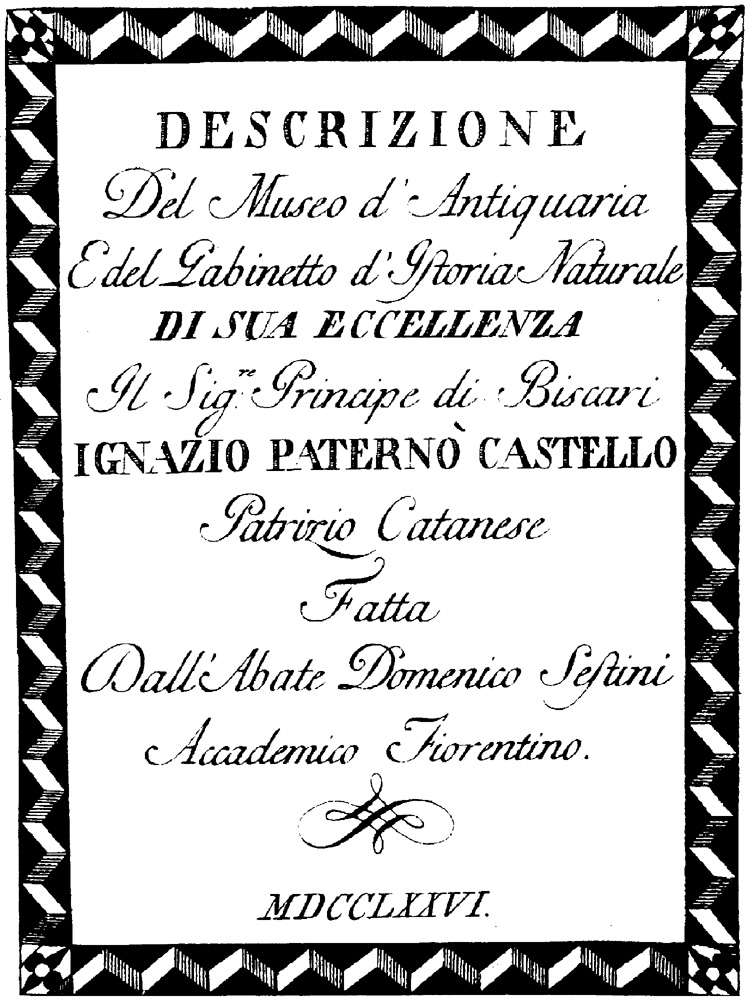SESTINI, Domenico.
(1750 – 1832)
Sestini was librarian to Prince Biscardi, and he was instrumental in helping build the royal collections. He made an extended voyage of the orient of which 9 volumes of letters were published between 1779 and 1785. An expert on coins, he left unfinished at his death, the 14 volume manuscript, Systema Geographicum Numismaticum.
Biographical references: ABI: I 908, 142-166; II 574, 90. • Benvenuti, Dizionario degli Italiani all'Estero, 1890. • Biographie Universelle: 39, 171-3. • Imperatori, Dizionario di Italiani all'Estero, 1956. • WBI.

1. Italian, 1776 [Collection catalog].
[Contained within an ornate border:] Descrizione | Del Museo d'Antiquaria | E del Gabinetto d'Istoria Naturale | Di Sua Eccellenza | Il Sig:re Principe di Biscari | Ignazio Paternò Castello | Patrizio Catanese | Fatta | Dall'Abate Domenico Sestini | Accademico Fiorentino. | [ornament] | MDCCLXXVI.
8°: [2], XI, 108 p., frontispiece, one plate. Engraved title page. Page size: 220 x 140 mm.
Rare. Catalog of a royal collection formed by Prince Ignazio Paterno Castello de Biscari [1719-1786]. It contained artificial and natural items from throughout Europe, plus a remarkable suite of specimens from Sicily. It was probably the southernmost Wunderkammer in Europe containing scientific instruments, optical devices, suites of armor, edged weapons and firearms, costumes, textiles, minerals and figured stones, natural history specimens, an important collection of coins and medals, sculptures and antiquities. Goethe was impressed by a visit in 1787 by the amber and ivory contained in the cabinet. The preface is signed Giovanni Mariti.
There is some question as to which city this book was published. Some sources say Florence while others give Livorno.
Bibliographical references: BL [1103.c.2.(5.)]. • Cabinets de Curiosités: no. 43. • Gatterer, Mineralogischen Literatur, 1798-9: 1, 280 [wrong year]. • Murray, Museums, 1904: 2, 119. • NUC: 539, 407 [NS 0433784]. • Wilson, History of Mineral Collecting, 1994: 161.
2. Italian, 1787 [2nd edition].
Descrizione | Del | Museo D'Antiquaria | E Del | Gabinetto D'Istoria Naturale | Del Signor | Principe Di Biscari | Fatta Dal Sig. | Abate Domenico Sestini | Accademico Fiorentio. | Nouva Edizione | Riveduta, Corretta, Ed Accresciuta | Dall' Autore. | [ornament] | Livorno 1787. | Per Carlo Giorgi Editore, ed Impressore. | [ornate rule] | Con Approvazione.
8°: xx, 53 p., frontispiece (portrait of Prince Biscari), 3 engraved plates (2 folding).
Plates: The frontispiece portrait of Biscari is signed: Catanae Antonius Zacco inv. et incidit. Plate [4] is a floor plan of the museum.
Rare. Edited by C. Giorgi. This revised edition, printed in the same year as the Prince's death, contains a new preface describing the interior of the palace and a detailed plan showing the layout of the collections within the galleries.
Goethe provides an interesting first-hand account of a visit to the museum in his Italian Journey. After visiting the main gallery with its collection of marble and bronze statues and vases, he was shown the coin collection, which was usually off limits due to theft. Then Goethe was escorted to the inner chambers to view a glass cabinet containing the collection of amber. Contained there were vessels, cups, urns and other things carved from it. In addition, there were also some exceptional carved ivories.
Bibliographical references: BL [665.e.27]. • Cabinets de Curiosités: no. 44. • Murray, Museums, 1904: 2, 119. • NUC [no copy listed]. • Wunderkammer to Museum: no. 36.
.